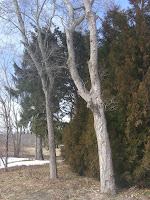Baum introduces his first Oz character with these words:
"There was a great cornfield beyond the fence, and not far away she saw a Scarecrow, placed high on a pole to keep the birds from the ripe corn ... Its head was a small sack stuffed with straw, with eyes, nose and mouth painted on it to represent a face. An old, pointed blue hat, that had belonged to some Munchkin, was perched on this head, and the rest of the figure was a blue suit of clothes, worn and faded, which had also been stuffed with straw. On the feet were some old boots with blue tops, such as every man wore in this country, and the figure was raised above the stalks of corn by means of the pole stuck up its back."
Fifteen years after the first book, the Scarecrow become the title character in Baum's The Scarecrow of Oz . The Scarecrow "type" seems to go through minor variations in the early years.
It's hard to imagine any other actor playing the part of the Scarecrow other than Ray Bolger. However, he was originally cast as the Tin Man. As fate would have it, the roles were switched prior to the production. Personally, I always felt a little bad for the Tin Man and Lion when Dorothy confesses to the scarecrpw, "I think I'll miss you most of all," before climbing into the balloon. Later I learned that MGM had a love interest plot between Dorothy and Hunk, the farmhand who became the scarecrow in Dorothy's dream, linking the two. Thank goodness someone had the brains to not go there.
Dorothy: Now which way do we go?
Scarecrow: Pardon me, this way is a very nice way.
Dorothy: Who said that?
[Toto barks at scarecrow]
Dorothy: Don't be silly, Toto. Scarecrows don't talk.
Scarecrow: [points other way] It's pleasant down that way, too.
Dorothy: That's funny. Wasn't he pointing the other way?
Scarecrow: [points both ways] Of course, some people do go both ways.
A more recent image (2008) of the Scarecrow for Marvel Comics by the creative team of Skottie Young and Eric Shanower.
For the Museum's Wee Faerie Village in the Land of Oz faerie Scarecrow, the illustrator took a walk on the wild side, literally. According to Miller, the scarecrow faerie "had the potential to go in so many different directions. But I knew he would be made out of garden detritus. I spent the most time wandering through the neighbor's garden thinking about this character. I brought a lot of stuff into the studio from the garden. Which helped on the rest of the character concepts too."
The final design paid homage to some of the earlier faerie illustrations using maple seedling for wings.David D.J. Rau
Director of Education and Outreach
David D.J. Rau coordinates as well as participates in the Museum’s October creative endeavors. You can contact him at david@flogris.org.
























































